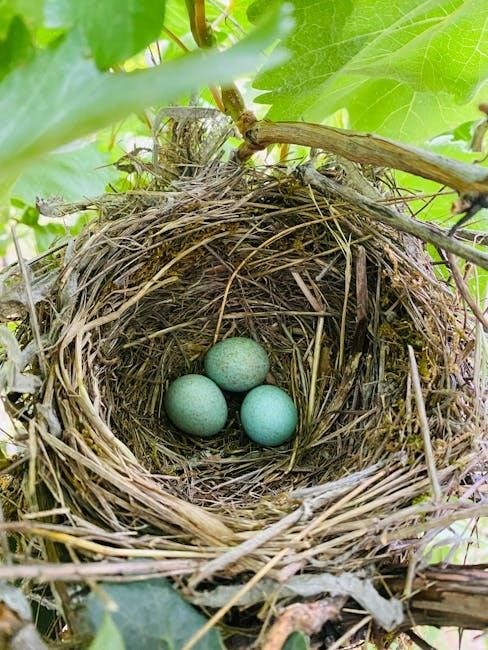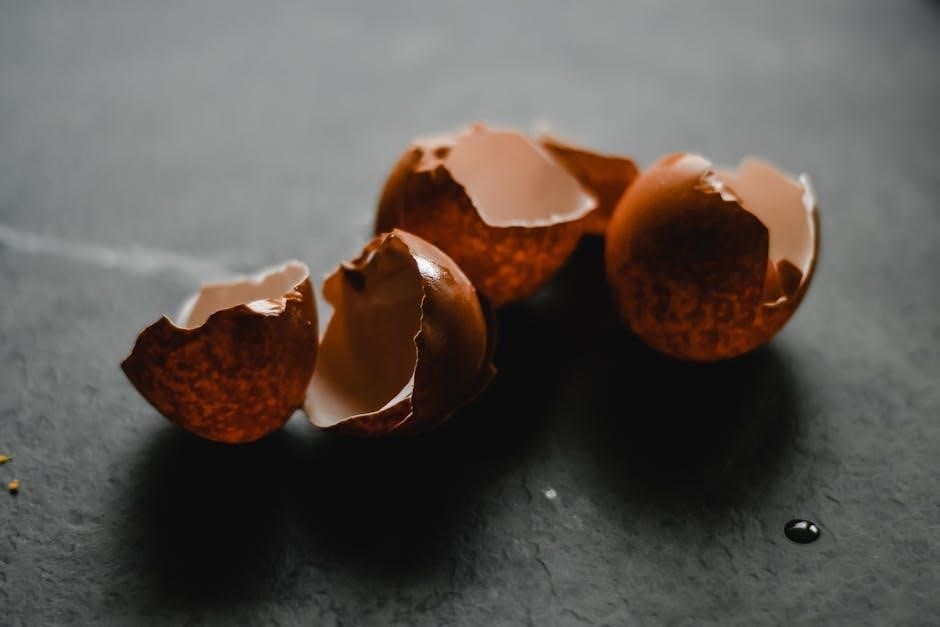
An egg incubator is a device that mimics natural incubation by controlling temperature, humidity, and turning eggs. Proper incubation is crucial for successful hatching, making incubators essential for both home and commercial use.
1.1 Importance of Proper Incubation
Proper incubation is critical for successful hatching, as it ensures optimal conditions for embryo development. Maintaining precise temperature, humidity, and egg turning schedules mimics natural incubation, reducing the risk of developmental issues. Even slight deviations can lead to poor hatch rates or malformed chicks. Humidity levels prevent excessive moisture loss, while consistent temperature prevents embryo stress. Regular egg turning promotes even growth, avoiding deformities. Sanitation is equally vital to prevent bacterial contamination, which can halt development. Proper incubation creates a stable environment, maximizing hatch success and producing healthy chicks. Neglecting these factors can result in failed hatches or weakened offspring. Thus, attention to detail and adherence to guidelines are essential for achieving optimal results.

1.2 Brief Overview of the Incubation Process
The incubation process typically lasts 21 days, carefully replicating natural conditions to support embryo development. It begins with preparing the incubator, ensuring proper temperature (99-100°F) and humidity levels (around 50-60%). Eggs are placed in the incubator, either manually turned or using an automatic turning mechanism. Regular monitoring of temperature and humidity is essential, with adjustments made as needed. Candling eggs after 7-10 days helps identify fertile eggs and monitor growth. During the final days, humidity is increased to facilitate hatching. The process requires consistent attention to detail to ensure optimal conditions for successful hatching. Proper preparation and adherence to guidelines are key to achieving a high hatch rate and healthy chicks.

Preparing for Incubation
Preparing for incubation involves selecting fertile eggs, cleaning the incubator, and ensuring all settings are correct. This step is crucial for creating a safe and optimal environment for embryo development.

2.1 Selecting Fertile Eggs for Incubation
Selecting fertile eggs is the first critical step in successful incubation. Ensure eggs are clean, dry, and free from cracks or damage. Store them pointed end down at 50-60°F (10-15°C) before incubation. Avoid eggs with visible defects or abnormal shapes, as these can reduce hatch rates. Freshness is key—fertile eggs should be no more than 7-10 days old. Candling can help identify fertile eggs by revealing clear air sacs and visible embryonic development. Proper handling and storage prevent embryo damage. Always follow manufacturer guidelines for egg preparation and selection to maximize hatchability and ensure a healthy start for your chicks.
2.2 Cleaning and Sanitizing the Incubator

Cleaning and sanitizing the incubator is essential to ensure a healthy environment for embryo development. Start by rinsing water pans and egg trays with warm water mixed with a small amount of bleach or disinfectant. Avoid using harsh chemical cleansers, especially on the incubator’s bottom, as they can release harmful toxins. Soak components in warm water if necessary, then rinse thoroughly; Dry all parts before reassembling the incubator. Sanitize surfaces with a solution of 1 part bleach to 10 parts water, ensuring no chemical residue remains. Regular cleaning prevents bacterial growth and contamination, which can harm embryos. Always sanitize the incubator before and after use, especially after hatching, to maintain hygiene and prevent disease spread. Proper cleaning ensures optimal conditions for successful incubation and healthy chick development.
2.3 Pre-Incubation Checks and Preparations
Before starting the incubation process, conduct thorough checks to ensure everything is ready. Test the incubator by running it for 24-48 hours to confirm temperature and humidity levels are stable and within the recommended range. Allow the incubator to stabilize before adding eggs. Check all components, such as water pans, egg trays, and turning mechanisms, to ensure they are functioning properly. Store eggs pointed end down in a cool, dry place before incubation and let them acclimate to room temperature for a few hours. Assemble the incubator according to the manufacturer’s instructions and ensure all parts are clean and sanitized. Place cheesecloth under the egg tray to catch shell fragments during hatching. Finally, prepare a brooder for newly hatched chicks, ensuring it is warm, safe, and equipped with food and water. Proper preparation ensures a smooth and successful incubation process.

Setting Up the Incubator
Setting up the incubator involves adjusting temperature, humidity, and egg turning mechanisms. Follow manufacturer instructions to ensure proper function. Test the incubator before adding eggs to confirm stability.
3.1 Adjusting Temperature Settings
Adjusting temperature settings is critical for successful incubation. Most incubators require a temperature of 99-100°F (37.2-37.8°C) for chicken eggs. Ensure the incubator is preheated and stable before adding eggs. Slight variations may exist for different species, so consult the manufacturer’s guidelines. Avoid sudden temperature drops or spikes, as they can harm embryos. Use the incubator’s controls to fine-tune the temperature, and consider calibrating the device if necessary. Always monitor temperature readings closely during the incubation period to maintain consistency. Proper temperature control is essential for healthy development and hatch rates. Refer to the incubator’s manual for specific adjustment instructions, as different models may have varying procedures. Stability is key to ensuring optimal conditions for embryonic growth.
3.2 Maintaining Proper Humidity Levels
Maintaining proper humidity levels is essential for successful incubation. Most incubators require a humidity range of 50-60% during the first 18 days, increasing to 70-80% during hatching. Use water reservoirs or pans provided with the incubator to regulate humidity. Fill them as instructed, ensuring water levels are adequate but not excessive. Monitor humidity using a built-in hygrometer or digital sensor. If humidity is too low, gently mist water into the incubator with a clean spray bottle. Avoid over-saturating, as this can lead to mold or poor air circulation. For species-specific needs, adjust humidity according to the manufacturer’s guidelines. Proper humidity ensures healthy embryonic development and prevents shell deformities. Regularly check and refill water reservoirs to maintain consistent conditions throughout the incubation period. This careful balance supports optimal hatching success and chick health.
3.3 Initial Calibration of the Incubator
Before starting the incubation process, calibrating the incubator is crucial to ensure accurate temperature and humidity readings. Place the incubator in a stable environment, away from drafts, and allow it to run for 24 hours. Use a digital thermometer and hygrometer to verify the incubator’s temperature (typically 99-100°F) and humidity levels (50-60%). If the readings differ, adjust the incubator’s settings accordingly. Some models may require manual calibration, while others automatically adjust. Always refer to the manufacturer’s instructions for specific calibration steps. Proper calibration ensures optimal conditions for embryo development and minimizes risks of temperature or humidity fluctuations. Once calibrated, double-check the settings before adding eggs to guarantee a successful incubation process.

The Incubation Period
The incubation period typically lasts 21 days, requiring consistent monitoring of temperature, humidity, and egg turning; Daily checks ensure optimal conditions for embryo development and successful hatching.
4.1 Daily Monitoring of the Incubator
Daily monitoring of the incubator is essential to ensure optimal conditions for embryo development. Check the temperature, maintaining it between 99°F and 100°F, and humidity levels, which should range from 50% to 60% during the first 18 days. Use a hygrometer for accurate readings and adjust water pans as needed. Verify that eggs are turning correctly, either manually or automatically, to prevent developmental issues. Candling eggs periodically can help identify any abnormalities or stalled development. Ensure the incubator is clean and free from bacteria to promote a healthy environment. Regularly inspect the power supply and ensure all functions are operating smoothly; By maintaining consistent and precise conditions, you can maximize the chances of successful hatching and healthy chicks.
4.2 Managing Humidity During Incubation
Humidity control is critical during incubation to ensure proper embryo development. For the first 18 days, maintain humidity levels between 50% and 60% by filling water pans as instructed. After day 18, increase humidity to 70% to 75% to facilitate hatching. Use a hygrometer to monitor levels accurately. If humidity is too low, add water to the pans; if too high, reduce water or slightly vent the incubator. Cheesecloth can be placed under the egg tray to catch shell fragments during hatching. Avoid sudden humidity changes, as they can cause condensation on eggshells, leading to disease or reduced hatch rates. Regularly check water levels and adjust as needed to maintain a stable environment for healthy development and successful hatching.
4.3 Turning Eggs Manually or Automatically
Turning eggs is essential to ensure even heating and prevent the embryo from sticking to the shell. Manual turning involves gently rotating eggs 180 degrees 2-3 times daily, while automatic incubators handle this with a built-in turning mechanism. For manual turning, mark eggs with a pencil to track rotation. Automatic turners eliminate the need for manual intervention, reducing the risk of human error. Ensure the incubator’s turning function is properly aligned and functioning smoothly. If using manual turning, avoid over-handling eggs, as this can introduce bacteria or damage embryos. Always follow the manufacturer’s instructions for turning, whether manual or automatic, to optimize hatch rates and embryo health. Consistent and careful turning is vital for successful incubation and healthy chick development.

4.4 Candling Eggs to Check Development
Candling eggs involves shining a bright light through the egg to monitor embryo development. This process is typically done on days 7 and 14 of incubation. Use a candling device or a bright flashlight in a dark room to illuminate the egg. You should see visible veins and a dark spot indicating the embryo. Clear eggs may indicate infertility, while dark or cracked eggs could signal issues. Avoid candling too frequently to prevent unnecessary stress on the eggs. Always handle eggs gently and briefly to maintain incubator stability. This method helps identify healthy development and detect potential problems early, ensuring a higher success rate for hatching. Regular candling is a crucial step in monitoring the progress of your eggs during incubation.
The Hatching Process
The hatching process typically begins after 21 days of incubation, lasting 24 hours. Eggs pip first, followed by zipping as chicks emerge. Maintain humidity and avoid opening the incubator during hatching to ensure success.
5.1 Understanding the Hatching Timeline
The hatching process typically begins around day 21 of incubation, though it can vary slightly depending on species. Eggs start with a small pip, where the chick breaks through the shell internally. This is followed by zipping, where the chick creates a crack around the shell. Full emergence usually occurs within 24 hours. Maintaining proper humidity and avoiding opening the incubator during this critical period is essential. Chicks generally hatch within a few hours of each other, but some may take longer. It’s important to monitor the incubator closely but avoid interference. Once hatched, chicks will dry and fluff out, ready for transfer to a brooder. Patience is key, as the hatching timeline can vary slightly due to factors like breed and incubation conditions.
5.2 Recognizing Signs of Hatching
As hatching approaches, visible signs include small cracks or pips in the eggshell, followed by the chick breaking through internally. This process, called pipping, is a clear indicator that hatching is imminent. You may also hear faint peeping sounds from the chick. Shortly after pipping, the chick will begin zipping, where it creates a crack around the shell’s circumference. The chick will then fully emerge, often within a few hours. It’s important to maintain high humidity during this phase to prevent the membrane from drying out. Avoid opening the incubator excessively, as this can disrupt the process. Once the chick is fully hatched, it will dry and fluff out, signaling it’s ready for transfer to a brooder. Monitoring these signs ensures you can provide the best environment for successful hatching.
Caring for Newly Hatched Chicks
Provide a safe, warm environment with proper ventilation. Ensure access to fresh water and starter feed. Monitor health and cleanliness to support growth and well-being.
6.1 Providing a Safe Environment
Creating a safe environment for newly hatched chicks is essential for their survival and growth. Ensure the space is free from drafts, predators, and hazards. Provide a clean, dry brooder with adequate ventilation to prevent ammonia buildup. Line the floor with absorbent material like wood shavings or paper towels. Maintain a consistent temperature, starting around 90-95°F for the first week, gradually decreasing by 5°F each week. Use a heat source, such as a heat lamp, but ensure it’s safely secured to avoid fires. Keep the area quiet and stress-free. Place food and water within easy reach, and ensure the chicks can move freely without overcrowding. Consider using cheesecloth to catch eggshell fragments during hatching. A secure, well-prepared environment helps chicks thrive and reduces mortality rates.
6.2 Feeding and Hydration for New Chicks

Proper feeding and hydration are critical for the health and growth of newly hatched chicks. Start with a high-quality chick starter feed, which provides essential nutrients for development. Place feeders and waterers at a height that allows easy access but prevents contamination. Ensure fresh, clean water is always available to prevent dehydration. Avoid giving chicks untreated water or food scraps, as these can lead to health issues. Offer feed in small, frequent portions to encourage eating and reduce waste. Monitor the chicks’ eating habits and adjust portions as needed. Avoid feeding them raw or uncooked foods, as these can pose health risks. Provide a clean, dry environment for feeding to prevent the spread of disease. Consult a veterinarian for personalized feeding advice tailored to your chicks’ needs.

Troubleshooting Common Issues
Common issues include incorrect temperature, humidity imbalances, or poor ventilation. Adjust settings, ensure proper airflow, and monitor egg development. Seek professional help if problems persist despite corrective measures.
7.1 Identifying and Solving Common Problems
Common issues during incubation include temperature fluctuations, humidity imbalances, and improper egg turning. To address these, ensure the incubator is placed in a stable environment and regularly monitor settings. If temperature or humidity levels deviate, adjust the incubator’s controls and verify with a secondary thermometer or hygrometer. For manual turning, maintain a consistent schedule to prevent developmental issues. Clean the incubator with mild disinfectants to avoid contamination. If problems persist, refer to the manufacturer’s troubleshooting guide or consult a professional. Proper maintenance and timely interventions can significantly improve hatch rates and overall success.
7.2 When to Seek Professional Help
If you encounter persistent issues with your egg incubator despite troubleshooting, it may be time to seek professional assistance. This is especially true for mechanical failures, such as faulty temperature or humidity controls, which can critically affect embryo development. Additionally, if contamination or mold growth occurs and cannot be resolved with basic cleaning, consult a professional to avoid further complications. If you’re unsure about advanced settings or interpretations of incubator data, reaching out to an expert can provide clarity and ensure optimal conditions for hatching. Professional help is also recommended if you notice unusual egg development or if multiple eggs fail to hatch, as these could indicate underlying issues requiring specialized knowledge or equipment; Timely intervention can prevent losses and improve overall incubation success.
Successful incubation requires careful attention to temperature, humidity, and egg handling. By following guidelines and maintaining optimal conditions, you can achieve a high hatch rate and healthy chicks.
8.1 Final Thoughts on Successful Incubation
Successful incubation hinges on meticulous attention to temperature, humidity, and egg handling. Consistently following manufacturer guidelines ensures optimal conditions for embryo development. Regular monitoring and adjustments are crucial to maintain stability, while gentle handling prevents damage to delicate eggs. Patience and dedication are key, as the incubation process requires daily checks and a clean environment. By adhering to these practices, you can maximize hatch rates and welcome healthy chicks. Remember, every step contributes to a successful outcome, making the effort rewarding and fulfilling for both beginners and experienced breeders alike.